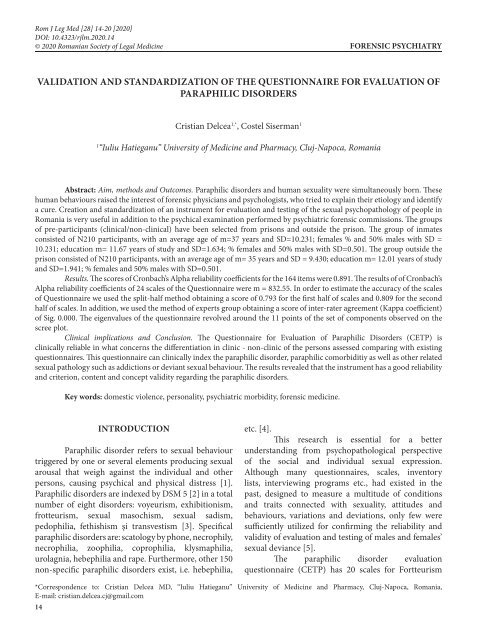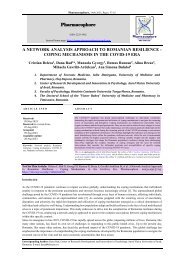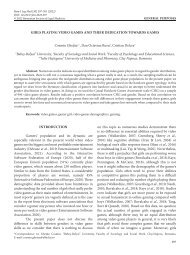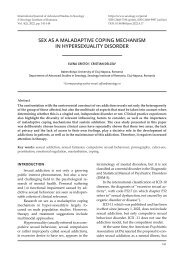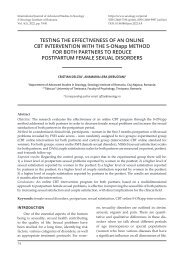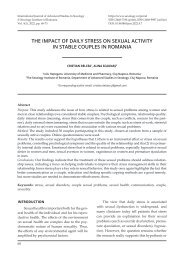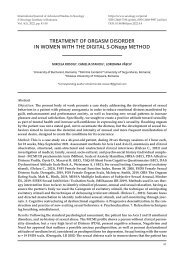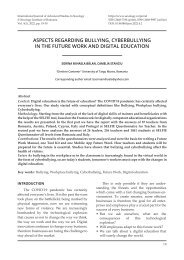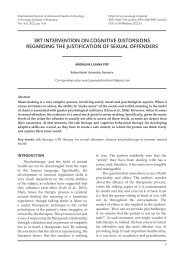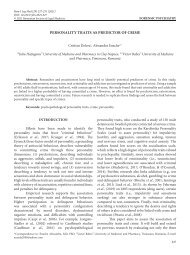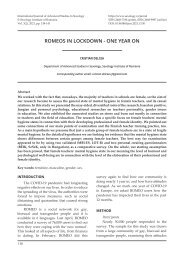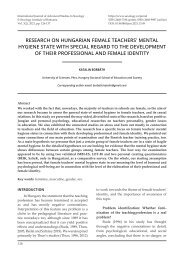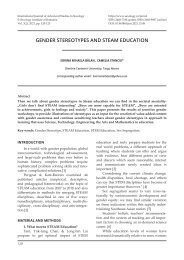VALIDATION AND STANDARDIZATION OF THE QUESTIONNAIRE FOR EVALUATION OF PARAPHILIC DISORDERS
Abstract: Aim, methods and Outcomes. Paraphilic disorders and human sexuality were simultaneously born. These human behaviours raised the interest of forensic physicians and psychologists, who tried to explain their etiology and identify a cure. Creation and standardization of an instrument for evaluation and testing of the sexual psychopathology of people in Romania is very useful in addition to the psychical examination performed by psychiatric forensic commissions. The groups of pre-participants (clinical/non-clinical) have been selected from prisons and outside the prison. The group of inmates consisted of N210 participants, with an average age of m=37 years and SD=10.231; females % and 50% males with SD = 10.231; education m= 11.67 years of study and SD=1.634;
Abstract: Aim, methods and Outcomes. Paraphilic disorders and human sexuality were simultaneously born. These
human behaviours raised the interest of forensic physicians and psychologists, who tried to explain their etiology and identify
a cure. Creation and standardization of an instrument for evaluation and testing of the sexual psychopathology of people in
Romania is very useful in addition to the psychical examination performed by psychiatric forensic commissions. The groups
of pre-participants (clinical/non-clinical) have been selected from prisons and outside the prison. The group of inmates
consisted of N210 participants, with an average age of m=37 years and SD=10.231; females % and 50% males with SD =
10.231; education m= 11.67 years of study and SD=1.634;
You also want an ePaper? Increase the reach of your titles
YUMPU automatically turns print PDFs into web optimized ePapers that Google loves.
Rom J Leg Med [28] 14-20 [2020]<br />
DOI: 10.4323/rjlm.2020.14<br />
© 2020 Romanian Society of Legal Medicine<br />
<strong>FOR</strong>ENSIC PSYCHIATRY<br />
<strong>VALIDATION</strong> <strong>AND</strong> ST<strong>AND</strong>ARDIZATION <strong>OF</strong> <strong>THE</strong> <strong>QUESTIONNAIRE</strong> <strong>FOR</strong> <strong>EVALUATION</strong> <strong>OF</strong><br />
<strong>PARAPHILIC</strong> <strong>DISORDERS</strong><br />
Cristian Delcea 1,* , Costel Siserman 1<br />
1<br />
“Iuliu Hatieganu” University of Medicine and Pharmacy, Cluj-Napoca, Romania<br />
Abstract: Aim, methods and Outcomes. Paraphilic disorders and human sexuality were simultaneously born. These<br />
human behaviours raised the interest of forensic physicians and psychologists, who tried to explain their etiology and identify<br />
a cure. Creation and standardization of an instrument for evaluation and testing of the sexual psychopathology of people in<br />
Romania is very useful in addition to the psychical examination performed by psychiatric forensic commissions. The groups<br />
of pre-participants (clinical/non-clinical) have been selected from prisons and outside the prison. The group of inmates<br />
consisted of N210 participants, with an average age of m=37 years and SD=10.231; females % and 50% males with SD =<br />
10.231; education m= 11.67 years of study and SD=1.634; % females and 50% males with SD=0.501. The group outside the<br />
prison consisted of N210 participants, with an average age of m= 35 years and SD = 9.430; education m= 12.01 years of study<br />
and SD=1.941; % females and 50% males with SD=0.501.<br />
Results. The scores of Cronbach’s Alpha reliability coefficients for the 164 items were 0.891. The results of of Cronbach’s<br />
Alpha reliability coefficients of 24 scales of the Questionnaire were m = 832.55. In order to estimate the accuracy of the scales<br />
of Questionnaire we used the split-half method obtaining a score of 0.793 for the first half of scales and 0.809 for the second<br />
half of scales. In addition, we used the method of experts group obtaining a score of inter-rater agreement (Kappa coefficient)<br />
of Sig. 0.000. The eigenvalues of the questionnaire revolved around the 11 points of the set of components observed on the<br />
scree plot.<br />
Clinical implications and Conclusion. The Questionnaire for Evaluation of Paraphilic Disorders (CETP) is<br />
clinically reliable in what concerns the differentiation in clinic - non-clinic of the persons assessed comparing with existing<br />
questionnaires. This questionnaire can clinically index the paraphilic disorder, paraphilic comorbiditiy as well as other related<br />
sexual pathology such as addictions or deviant sexual behaviour. The results revealed that the instrument has a good reliability<br />
and criterion, content and concept validity regarding the paraphilic disorders.<br />
Key words: domestic violence, personality, psychiatric morbidity, forensic medicine.<br />
INTRODUCTION<br />
Paraphilic disorder refers to sexual behaviour<br />
triggered by one or several elements producing sexual<br />
arousal that weigh against the individual and other<br />
persons, causing psychical and physical distress [1].<br />
Paraphilic disorders are indexed by DSM 5 [2] in a total<br />
number of eight disorders: voyeurism, exhibitionism,<br />
frotteurism, sexual masochism, sexual sadism,<br />
pedophilia, fethishism și transvestism [3]. Specifical<br />
paraphilic disorders are: scatology by phone, necrophily,<br />
necrophilia, zoophilia, coprophilia, klysmaphilia,<br />
urolagnia, hebephilia and rape. Furthermore, other 150<br />
non-specific paraphilic disorders exist, i.e. hebephilia,<br />
etc. [4].<br />
This research is essential for a better<br />
understanding from psychopathological perspective<br />
of the social and individual sexual expression.<br />
Although many questionnaires, scales, inventory<br />
lists, interviewing programs etc., had existed in the<br />
past, designed to measure a multitude of conditions<br />
and traits connected with sexuality, attitudes and<br />
behaviours, variations and deviations, only few were<br />
sufficiently utilized for confirming the reliability and<br />
validity of evaluation and testing of males and females’<br />
sexual deviance [5].<br />
The paraphilic disorder evaluation<br />
questionnaire (CETP) has 20 scales for Fortteurism<br />
*Correspondence to: Cristian Delcea MD, “Iuliu Hatieganu” University of Medicine and Pharmacy, Cluj-Napoca, Romania,<br />
E-mail: cristian.delcea.cj@gmail.com<br />
14
Validation and standardization of the questionnaire for evaluation of paraphilic disorders<br />
(Fr), Voyeurism (V), Exhibitionism (Ex), Public<br />
masturbation (Pm), Sexual Sadism (S), Sexual (Ma),<br />
Fethishism (Fe), Transvestic Fethishism (Tf), Pedophilia<br />
(P), Hebophilia (H), Rape (R), Uropilia (U), Clinic<br />
Comorbidity (Cc), Klysmaphilia (K), Coprophilia (C),<br />
Necrophilia (N), Scatology by phone (Ts), Zoophilia<br />
(Z), Social Desirability (Y), Denial (N) out of which<br />
(Y, N) two scales are not validated, one regarding<br />
comorbidity (Cc) and 17 scales regarding specific and<br />
non-specific paraphylic disorders.<br />
The formula for inventory items (CETP)<br />
was written according to the specialty literature<br />
regarding specific and non-specific disorders [6],<br />
in order to differentiate one sexual deviance from<br />
another paraphilic disorders as well as other sexual<br />
psychopathologic morbidities and/or comorbidities<br />
[7].<br />
MATERIAL <strong>AND</strong> METHODS<br />
Participants<br />
Preliminary results for the clinic sample<br />
Participants from penitentiary were volunteers<br />
with criminal records for sexual crimes and other<br />
related crimes and/or with deviant sexual history. From<br />
N300 only N200 were selected. The selection criteria<br />
were gender (50% female F=100; 50% male F=100),<br />
age (average age = m 37.08 and SD=10.231), education<br />
(m= 11.67 grades and SD=1.634). Table 1 shows the<br />
descriptive results for the penitentiary/clinic sample.<br />
Preliminary results for the non-clinic sample<br />
The participants attending this study were<br />
volunteers outside the penitentiary, with a clear police<br />
record and without deviant sexual history. From N300<br />
only N200 were selected. The selection criteria were<br />
gender (50% females F=100; 50% males F=100), age<br />
(average age = m 35.00 and SD=9.430), educational<br />
level (m= 12.01 grades and SD=1.941). Table 2 shows<br />
the descriptive results regarding the non-penitentiary/<br />
non-clinic sample.<br />
Procedure<br />
Selection criteria for penitentiary/clinic group<br />
The participants involved in this research had<br />
to meet the following conditions: age between 18-90,<br />
have a police record of sexual crime or any other crime<br />
associated with the sexual crime, equal number of<br />
males and females in the Group (P), have graduated<br />
at least 8 grades and up to university studies, originate<br />
from several localities from Romania.<br />
Selection criteria for non-penitentiary/nonclinic<br />
group<br />
The participants involved in this research<br />
had to meet the following conditions: age between<br />
18-90, have not committed any sexual crime or any<br />
other crime associated with the sexual crime, equal<br />
number of males and females in the Group (NP), have<br />
graduated at least 8 grades and up to university studies,<br />
originate from several localities from Romania.<br />
Endeavours to form the penitentiary/clinic<br />
group<br />
Notifications requesting the approval of<br />
the research were sent to ANP (National Prison<br />
Administration). National Prison Administration<br />
Table 1. Descriptive results for the clinic sample<br />
Descriptive Statistics Clinic<br />
N Mean Std. Deviation<br />
Age 210 37.08 10.231<br />
Studies 210 11.67 1.634<br />
Sex 210 1.50 .501<br />
Valid N (listwise) 210<br />
Table 2. Descriptive results regarding Non-clinic sample<br />
Descriptive Statistics Non-clinic<br />
N Mean Std. Deviation<br />
Age 210 35.00 9.430<br />
Studies 210 12.01 1.941<br />
Sex 210 1.50 .500<br />
Valid N (listwise) 210<br />
Table 3. Cronbach’s Alpha coefficients for the whole questionnaire<br />
Cronbach’s Alpha<br />
Reliability Statistics<br />
N of Items<br />
.891 164<br />
15
Delcea C. and Siserman C.<br />
suggested several prisons in the country. Initially, the<br />
group consisted of N300 out of which N200 remained.<br />
The participants were informed about this study and<br />
according to their consent, each of them filled in the<br />
evaluation and underwent testing. Participants were<br />
assisted in filling in the questionnaires and provided<br />
with necessary support and information.<br />
Endeavours to form the non-penitentiary/nonclinic<br />
group<br />
Notifications requesting the approval of<br />
the research were sent to several universities in the<br />
country. Initially, the group consisted of N300 out<br />
of which N200 remained. The participants were<br />
informed about this study and depending on their<br />
consent, each of them filled in the measurement<br />
tool. The participants were assisted in filling in the<br />
questionnaires and provided with necessary support<br />
and information.<br />
Processing the data obtained from the 2 groups<br />
The participants filled in two sets of<br />
questionnaires (N 300 X 2). The gross results were<br />
manually introduced in databases and after their<br />
interpretation and manual delimitation, from the<br />
test samples, the gross scales of the evaluation were<br />
identified and used to create a databases for the SPSS.<br />
From the total number of 6 questionnaires (N 300 X<br />
2) made available to the participants, only 400 were<br />
validated after testing (N400 X 2). After Data collection,<br />
400 questionnaires were manually introduced in the<br />
databases of the SPSS 25.0 program. Processing of<br />
statistical data was made using IBM SPSS Statistics<br />
Subscription, Forecasting & Decision Trees.<br />
RESULTS<br />
Cronbach’s Alpha coefficients for the 164<br />
items for the whole Questionnaire<br />
The results in the Table 3 reveal a good internal<br />
reliability of the whole questionnaire containing<br />
164 items. The score of 0.891 of Cronbach’s Alpha<br />
coefficients represents the measure in which the<br />
items compounding the testing instrument (ETP) are<br />
internally preserved and coherent for the sample of<br />
examinees.<br />
Cronbach’s Alpha coefficients for the 20 scales<br />
of the Questionnaire<br />
The results in Table 4 reveal a good internal<br />
reliability of the 20 scales of the CETP Questionnaire.<br />
The score of 0.975 of Cronbach’s Alpha coefficients<br />
Table 4. Cronbach’s Alpha coefficients for the 20 scales of the Questionnaire<br />
Reliability Statistics<br />
Cronbach’s Alpha Cronbach’s Alpha Based on Standardized Item N of Scales<br />
.975 .975 20<br />
Table 5. Inter-scale consistency of the 20 scales in Questionnaire<br />
Item-Total Statistics<br />
Scale Mean if Item Deleted<br />
Scale Variance if Item<br />
Deleted<br />
Corrected Item-Total<br />
Correlation<br />
Cronbach’s Alpha if Item<br />
Deleted<br />
Fr 34.81 3.525 .770 .891<br />
V 34.91 3.155 .873 .850<br />
Ex 34.77 3.482 .794 .871<br />
Pm 34.79 3.636 .735 .803<br />
S 34.87 3.351 .964 .975<br />
Ma 34.77 3.416 .849 .859<br />
Fe 34.86 3.144 .676 .834<br />
Tf 34.77 3.433 .759 .863<br />
P 35.27 3.321 .843 .816<br />
H 34.96 3.416 .746 .805<br />
R 35.33 3.724 .766 .773<br />
U 34.77 3.382 .756 .855<br />
Cc 35.15 3.089 .787 .872<br />
K 34.77 3.442 .842 .665<br />
C 34.77 3.342 .794 .748<br />
N 34.76 3.523 .760 .875<br />
Ts 34.81 3.342 .800 .758<br />
Z 34.77 3.562 .744 .784<br />
Y 35.38 3.141 .860 .880<br />
Neg 34.96 3.235 .870 .874<br />
16
Validation and standardization of the questionnaire for evaluation of paraphilic disorders<br />
Table 6. Split-half method for assessing the consistency of the Questionnaire results<br />
Reliability Statistics<br />
Part 1<br />
Value .793<br />
N of Items<br />
10 a<br />
Cronbach’s Alpha<br />
Value .809<br />
Part 2<br />
N of Items<br />
10 b<br />
Total N of Items 20<br />
Correlation Between Forms .726<br />
Spearman-Brown Coefficient<br />
Equal Length .791<br />
Unequal Length .791<br />
Guttman Split-Half Coefficient .791<br />
a. The items are: Fr. V. Ex. Pm. S. Ma. Fe. Tf. P. H. b. The items are: R. U. Cc. K. C. N. Ts. Z. Y. Neg.<br />
Table 7. Symmetrical measurement of the assessment of evaluators involved in research<br />
Symmetric Measures<br />
Value Asymptotic Standard Error a Approximate T b Approximate Significance<br />
Measure of Agreement Kappa .177 .060 7.158 .000<br />
N of Valid Cases 1471<br />
a. Not assuming the null hypothesis. b. Using the asymptotic standard error assuming the null hypothesis.<br />
represents the measure in which the items<br />
compounding the scale of (CETP) Questionnaire are<br />
internally preserved and coherent for the sample of<br />
examinees.<br />
Cronbach’s Alpha coefficients for the 20 scales<br />
of the Questionnaire<br />
From the total number of items from the<br />
questionnaire scales we registered a low score of 0.665 at<br />
the K scale, but after the correction we obtained a score<br />
of 0.842 at adjusted Cronbach’s Alpha, meaning that no<br />
other items should be removed from the questionnaire.<br />
In conclusion, we have a good correlation between<br />
the items of the scale items and items of the whole<br />
Questionnaire (Table 5).<br />
Split-half method for assessing the reliability<br />
of the scales of Questionnaire<br />
Results obtained using the split-half statistical<br />
method for the items of the scale (Fr, V, Ex, Pm, S,<br />
Figure 1. Linear diagram of the eigenvalues of the factors in the<br />
Questionnaire.<br />
Ma, Fe, Tf, P, H.) as well as for the other part of the<br />
items of the scales (R, U, Cc, K, C, N, Ts, Z, Y, Neg.)<br />
of the Questionnaire are 0.793 respectively 0.809 at<br />
Cronbach’s Alpha. We have also observed that on<br />
alpha coefficients and on split-half method, the result<br />
reveal a unique measurement. Therefore, we have a<br />
good correlation between the scores obtained on the<br />
first half of items included in the questionnaire those<br />
obtained based on the second half of items of the<br />
questionnaire. In order to maintain the initial length<br />
of the Questionnaire, this correlation was solved using<br />
statistic adjustment (Table 6).<br />
Inter-rater agreement (Kappa coefficient)<br />
When applying this method to the experts<br />
involved in qualitative rating of the Questionnaire<br />
items, the score resulted was 0.177 and one Sig. 0.000.<br />
This value shows a good level of agreement between<br />
the experts involved in the recorded assessments.<br />
Moreover, these data reveal that the experts’<br />
assessments of the information obtained based on the<br />
open questions regarding the items of questionnaire,<br />
the answers and its interpretation are qualitative<br />
quantified. Table 7 shows the results obtained by using<br />
statistical method and Kappa calculus method.<br />
The eigenvalues of the Questionnaire are seen<br />
bellow in a descending curve, ranking the eigenvalues<br />
from the highest to the lowest. According to the screen<br />
test, “the elbow” of the graph where the eigenvalues<br />
seem to level out, identify the factors or components<br />
in the left side of this point, which preserve as well the<br />
results obtained (Fig. 1).<br />
17
Delcea C. and Siserman C.<br />
Correlations between the Questionnaire of<br />
Evaluation of Paraphilic Disorders (CETS) and other<br />
similar scales<br />
In the Table 8 we can observe a very good<br />
result regarding the fidelity of 0.88 for the whole<br />
Questionnaire and on the test-retest the correlations<br />
were 0.91. Table 8 reveals the results obtained when<br />
comparing our Questionnaire with other similar<br />
evaluation instruments and tests.<br />
Statistical significance when measuring<br />
sampling adequacy<br />
We have also used the statistical method which<br />
was a Kaiser-Meyer-Olkin (KMO) measurement of<br />
sampling adequacy showing the variance proportion<br />
of the 2 groups involved in research and which might<br />
be caused by basic factors. The high values ( KMO =<br />
0.939, Sig. = 0.000, Chi-Square = 12781.147) usually<br />
show that analysis of factors might be useful for our<br />
suggested data. Therefore, since we have a very good<br />
value of 0.939, the results of analysis of factors have<br />
statistical significance for sampling adequacy from<br />
the perspective of preparing and standardization of<br />
Questionnaire. Table 9 shows the accuracy of data<br />
expressed and expected by us.<br />
Results obtained at clinic/non-clinic<br />
differentiation for the Questionnaire<br />
The results mentioned bellow prove the<br />
reliability of differentiation between the group of<br />
inmates charged with sexual offences and the group<br />
outside prison without sexual offences or paraphilic<br />
disorders. We obtained the score F=790.001 and<br />
Sig.=0.000. Thus, the data from the Table 10 prove that<br />
in one assessment, the test can make the differentiation<br />
from the clinic/non-clinic perspective of the person<br />
undergoing testing.<br />
Table 8. Comparisons of Fidelity Coefficients for the CETS and Other Similar Scales<br />
Scale/Questionnaire Cronbach’s Alpha Test-retest Correlation<br />
Questionnaire for Evaluation of Paraphilic Disorders (CETS) .89 .91<br />
The Child Sexual Abuse Scale (CSAS) .81 .84<br />
Sexual Socialization Instrument (SSI) .78 .85<br />
Rape Supportive Attitude Scale (RSAS) .91 .91<br />
The Sexual Risk Behaviour Beliefs and Self-Efficacy .96 .97<br />
Cross-Gender Fetishism Scale .95 .95<br />
Multidimensional Measure of Comfort with Sexuality .93 .93<br />
Hurlbert Index of Sexual Assertiveness (HISA) .85 .86<br />
Sexual Coercion Scale (SCS) .67 .70<br />
Compulsive Sexual Behaviour Inventory (CSBI) .86 .93<br />
Double Standard Scale (DSS) .72 .80<br />
Table 9. KMO and Bartlett’s Test<br />
Kaiser-Meyer-Olkin Measure of Sampling Adequacy. .939<br />
Bartlett’s Test of Sphericity Approx. Chi-Square 12781.147<br />
Table 9. ANOVA<br />
df 36<br />
Sig............................................................................000<br />
Clinical/Nonclinical<br />
Sum of Squares df Mean Square F Sig.<br />
Between Groups 798.989 2 199.747 790.001 .000<br />
Within Groups 201.011 795 .253<br />
Total 1000.000 799<br />
18
Validation and standardization of the questionnaire for evaluation of paraphilic disorders<br />
DISCUSSION<br />
In this Article, the results of the research reveal<br />
the correlation between the theoretical approaches<br />
regarding paraphilic psycho-pathological behaviour<br />
and reliability of clinical/non-clinical differentiation of<br />
the CETP Questionnaire.<br />
The preliminary data show the descriptive and<br />
statistical homogeneity on age, gender and education<br />
between the two groups. There is no doubt that the<br />
females sample regarding the homogeneity of sexual<br />
offences did not sufficiently meet the eligibility criteria<br />
comparing with the males from the same clinical<br />
sample. We took into consideration the offences<br />
associated with a deviant sexual behaviour for the<br />
female group in order to meet the eligibility criteria,<br />
without influencing the variables proposed for these<br />
researches.<br />
The eligibility criteria were significantly<br />
underlined with ANOVA statistical method for<br />
clinical/non-clinical samples. Moreover, we obtained<br />
very good results in what concerns the differentiation<br />
of the groups involved in research. We considered all<br />
data from the specialty literature in order to foreclose<br />
any aberration or risk factors which might occur when<br />
using the variables proposed in this research [9].<br />
The results obtained on Cronbach’s Alpha<br />
coefficients of the 164 items of the whole Questionnaire<br />
are significant. The importance of these data outlines the<br />
reliability of the items proposed in the Questionnaire<br />
and provides the guarantee of consistency which this<br />
instrument of evaluation and testing of paraphilic<br />
disorders has to generate measurements in psychopathological<br />
domain. In addition, we asked ourselves<br />
if this Questionnaire has a constant of measurement<br />
or consistency for all variables of the test, and we<br />
observed that this Questionnaire has a good reliability<br />
of the answers of the participants in evaluation [10].<br />
In order to assess the reliability of items and scales of<br />
the Questionnaire we used the statistical constancy<br />
method for Cronbach’s Alpha coefficients and for the<br />
20 scales of the Questionnaire. We found out that the<br />
items have a good constancy on scales. The statistical<br />
methods used were processed using programs<br />
especially designed for this domain, thus preventing<br />
any calculus error that might have occurred in our<br />
research [11].<br />
In what concern the results obtained using<br />
the split-half method for assessing the reliability of the<br />
scales of Questionnaire, we observed a good correlation<br />
between the scores registered based on the first half<br />
of the items and those based on the second half of<br />
the items included in the Questionnaire. In order to<br />
maintain the initial length of the Questionnaire, this<br />
correlation was solved using statistic adjustment. The<br />
specialty literature [12] reveals this validity with the<br />
purpose of providing supplementary data which might<br />
verify the reliability of constancy in a Questionnaire.<br />
In addition, we used the Kappa method<br />
for the experts involved in qualitative rating of the<br />
items in order to identify the qualitative agreements<br />
(correlations) expressed by the experts in what concern<br />
the estimations recorded. Moreover, these data reveal<br />
that the assessment made by experts of the information<br />
resulted from the open questions related to the items of<br />
Questionnaire, the answers and the interpretation of<br />
the Questionnaire are qualitative quantified [13].<br />
Other correlations between the Questionnaire<br />
for Evaluation of Paraphilic Disorders (CETS) and<br />
other similar scales had been suggested in order to<br />
compare the results obtained to test-retest correlations.<br />
After making a comparison with other Questionnaires,<br />
we found out that there is a good correlation which<br />
is similar to following tests: The Child Sexual Abuse<br />
Scale (CSAS), The Sexual Risk Behaviour Beliefs<br />
and Self-Efficacy, Cross-Gender Fetishism Scale and<br />
Compulsive Sexual Behaviour Inventory-CSBI [14].<br />
There is a high statistical significance for<br />
adequacy of sampling, which suggests that the<br />
samples involved in our research for validating the<br />
Questionnaire have a good level of adequacy. As a result,<br />
the results of analysis of the factors, which reach a very<br />
good value of 0,939 have a statistical significance for the<br />
adequacy of samples in what concern the preparation<br />
and standardization of Questionnaire [15].<br />
The results reported to clinic/non-clinic<br />
differentiation are significant which led us to the<br />
conclusion that the Questionnaire can differentiate<br />
a person with sexual paraphilic disorder from other<br />
person without paraphilic disorder [16].<br />
In conclusion, the Questionnaire for<br />
Evaluation of Paraphilic Disorders meets all criteria<br />
for assessment and testing of sexual psychopathology.<br />
It has a good inter-item reliability, both of the whole<br />
Questionnaire and of the scales in the Questionnaire.<br />
In addition, this Questionnaire reveals a good interrater<br />
correlation and is in agreement with other similar<br />
scales related to the evaluation of paraphilic disorders /<br />
deviant sexual behaviours.<br />
Furthermore, the Questionnaire has significant<br />
results for differentiation of clinical versus non-clinical<br />
groups and reported high scores to sampling adequacy<br />
19
Delcea C. and Siserman C.<br />
in preparation, validation and standardization of the<br />
Questionnaire.<br />
This Questionnaire can be used in written form<br />
or in electronic form. It comprises 164 questions, and<br />
has dichotomic answers. Depending on the prevalent<br />
answers, a general profile and/or a scale based profile<br />
can be made. The evaluation test is provided with test<br />
attending guidelines, a user’s guide for specialists and<br />
the licence to use. It is made in Romanian language and<br />
can be used with the previous approval of the authors.<br />
Conflict of interest<br />
The authors declare that they have no conflict of<br />
interest.<br />
Financial disclosure<br />
No financial support was received while the work<br />
was being organized. This study was conducted only in Moldova,<br />
Northeast of Romania. To gain more data in this regard<br />
it is necessary that the questionnaire to be distributed in other<br />
areas of the country.<br />
References<br />
1. Millon T, Krueger FR, Simonsen E. Contemporary Directions in<br />
Psychopathology: Scientific Foundations of the DSM-V and ICD-<br />
11. The Guilford Press. 2010.<br />
2. Diagnostic and Statistical Manual of Mental Disorders, 5 th<br />
Edition: DSM-5 by American Psychiatric Association. 2013.<br />
3. Laws L, O’Donohue TW. Sexual deviance: theory, assessment,<br />
and treatment — 2 nd ed. The Guilford Press. 2008.<br />
4. Milhausen RR, Sakaluk KJ, Fisher TD, Davis CM, Yarber WL.<br />
Handbook of Sexuality-Related Measures. Routledge; 4 th edition.<br />
2019.<br />
5. Zolondek SC, Abel GG, Northey WF Jr., Jordan A. Self-reported<br />
behaviors of juvenile sexual offenders. Journal of Interpersonal<br />
Violence. 2001; 16, 73–85.<br />
6. Bradford JM, Boulet J, Pawlak A. The paraphilias: A multiplicity<br />
of deviant behaviours. Canadian Journal of Psychiatry. 1992; 37:<br />
104–108.<br />
7. Laws R, O’Donohue TW. Sexual deviance: theory, assessment,<br />
and treatment. 2 nd ed. The Guilford Press. 2008.<br />
8. Federoff JP. The paraphilic world. In S. B. Levine, C. B. Risen, &<br />
S. E. Althof (Eds.), Handbook of clinical sexuality for mental health<br />
professionals (pp. 333–356). New York: Brunner- Routledge. 2003.<br />
9. Riaz NM. Test Construction Development And Standardization<br />
Of Psychological. Iqbal International Institute For Research And<br />
Dialogue. 2017.<br />
10. Miller AL, McIntire SA, Lovler RL. Foundations of Psychological<br />
Testing: A Practical Approach. SAGE Publications, Inc; Sixth<br />
edition. 2019.<br />
11. Field A. Discovering Statistics Using IBM SPSS Statistics: North<br />
American Edition. SAGE Publications Ltd; Fifth edition. 2017.<br />
12. Haslam SA, McGarty C. Research Methods and Statistics in<br />
Psychology. SAGE Publications Ltd; Third edition. 2018.<br />
13. Gurnsey R. Statistics for Research in Psychology: A Modern<br />
Approach Using Estimation.SAGE Publications, Inc. 2017.<br />
14. Hatcher L. Advanced Statistics in Research: Reading,<br />
Understanding, and Writing Up Data Analysis Results. Shadow<br />
Finch Media LLC. 2013.<br />
15. Pagano RR. Understanding Statistics in the Behavioral Sciences.<br />
Cengage Learning; 10 th edition. 2012.<br />
16. Jackson LS. Research Methods and Statistics: A Critical Thinking<br />
Approach. Cengage Learning 5 th Edition. 2015.<br />
20


